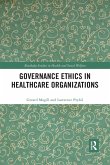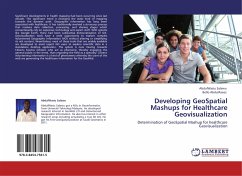Geospatial Information System Use in Public Organizations
How and Why GIS Should be Used in the Public Sector
Herausgeber: Valcik, Nicolas A.
Geospatial Information System Use in Public Organizations
How and Why GIS Should be Used in the Public Sector
Herausgeber: Valcik, Nicolas A.
- Gebundenes Buch
- Merkliste
- Auf die Merkliste
- Bewerten Bewerten
- Teilen
- Produkt teilen
- Produkterinnerung
- Produkterinnerung
This book shows how Global Information Systems (GIS) can be used for operations management in public institutions.
Andere Kunden interessierten sich auch für
![Industrial Organizations and Health Industrial Organizations and Health]() Industrial Organizations and Health232,99 €
Industrial Organizations and Health232,99 €![Industrial Organizations and Health Industrial Organizations and Health]() Industrial Organizations and Health65,99 €
Industrial Organizations and Health65,99 €![Governance Ethics in Healthcare Organizations Governance Ethics in Healthcare Organizations]() Gerard MagillGovernance Ethics in Healthcare Organizations52,99 €
Gerard MagillGovernance Ethics in Healthcare Organizations52,99 €![The Impact of the Covid-19 Pandemic on Public Health Students and Professionals in Germany. A Scoping Review The Impact of the Covid-19 Pandemic on Public Health Students and Professionals in Germany. A Scoping Review]() Awung Nkeze ElvisThe Impact of the Covid-19 Pandemic on Public Health Students and Professionals in Germany. A Scoping Review27,95 €
Awung Nkeze ElvisThe Impact of the Covid-19 Pandemic on Public Health Students and Professionals in Germany. A Scoping Review27,95 €![Developing GeoSpatial Mashups for Healthcare Geovisualization Developing GeoSpatial Mashups for Healthcare Geovisualization]() AbdulWasiu SalawuDeveloping GeoSpatial Mashups for Healthcare Geovisualization32,99 €
AbdulWasiu SalawuDeveloping GeoSpatial Mashups for Healthcare Geovisualization32,99 €![Managing and consequences of physician to patient ratio in health care organizations Managing and consequences of physician to patient ratio in health care organizations]() Kim WongManaging and consequences of physician to patient ratio in health care organizations17,95 €
Kim WongManaging and consequences of physician to patient ratio in health care organizations17,95 €![Marketing and Healthcare Organizations Marketing and Healthcare Organizations]() Colin GilliganMarketing and Healthcare Organizations48,99 €
Colin GilliganMarketing and Healthcare Organizations48,99 €-
-
-
This book shows how Global Information Systems (GIS) can be used for operations management in public institutions.
Produktdetails
- Produktdetails
- Verlag: Routledge
- Seitenzahl: 288
- Erscheinungstermin: 1. Oktober 2019
- Englisch
- Abmessung: 235mm x 157mm x 20mm
- Gewicht: 571g
- ISBN-13: 9781498767637
- ISBN-10: 149876763X
- Artikelnr.: 57928185
- Herstellerkennzeichnung
- Libri GmbH
- Europaallee 1
- 36244 Bad Hersfeld
- gpsr@libri.de
- Verlag: Routledge
- Seitenzahl: 288
- Erscheinungstermin: 1. Oktober 2019
- Englisch
- Abmessung: 235mm x 157mm x 20mm
- Gewicht: 571g
- ISBN-13: 9781498767637
- ISBN-10: 149876763X
- Artikelnr.: 57928185
- Herstellerkennzeichnung
- Libri GmbH
- Europaallee 1
- 36244 Bad Hersfeld
- gpsr@libri.de
Nicolas A. Valcik currently works as the Director of Institutional Research and Business Intelligence at the University of Texas at Permian Basin. Previously, Nicolas worked as the Executive Director for Institutional Effectiveness at Central Washington University, the Director for Institutional Research for West Virginia University, and as Associate Director of Strategic Planning and Analysis for the University of Texas at Dallas. In addition, Nicolas held an academic appointment as a Clinical Assistant Professor for Public Affairs for the University of Texas at Dallas. Prior to 1997, Nicolas worked for a number of municipalities, across different departments, as well as for Nortel. Nicolas received a doctorate in public affairs from the University of Texas at Dallas in 2005, a master's in public affairs from the University of Texas at Dallas in 1996, a bachelor's degree in interdisciplinary studies from the University of Texas at Dallas in 1994, and an associate's degree in political science from Collin County Community College in 1994.
Foreword. Acknowledgments. About the Editor. About the Authors. Section I:
Introduction 1. Introduction. Section II: Academic and Theoretical Research
GIS Topics 2. Hurricane Rita's Impact on Vegetation: A Spatio-Temporal
Statistical Approach to Characterizing Abrupt Change in, and Potential
Disaster Management for, Target Areas. 3. Evolving Trajectories in Public
Sector Statewide Spatial Data Infrastructure: From Data Product to
On-Demand Services and GIS Apps. 4. Using Geospatial Information Systems to
Preposition Logistics in Preparation for Hazardous Materials Incidents for
Disaster Response and Homeland Security Purposes. 5. Fire Disturbance and
Implications for Ecosystem Services Distribution in Northern Amazonia. 6.
Understanding Threats to Crowdsourced Geographic Data Quality Through a
Study of OpenStreetMap Contributor Bans. Section III: Applied Research
Using GIS 7. More Than Meets the Eye: The Methodological and
Epistemological Hazards of GIS Map Use in the Public Sphere. 8. Protecting
Surface Water Drinking Supplies in WV With Zones of Critical Concern.
Section IV: Practitioner Use of GIS in Public and Nonprofit Organizations
9. Uses of Geospatial Information Systems (GIS) for Public Higher Education
Institutions. 10. The Logistical Tracking System (LTS) Eighteen Years
Later: What Did We Learn and What Could We Improve? 11. Trends and
Challenges for Geographic Information Systems (GIS) Use by Nonprofits. 12.
West Virginia Trail Inventory. 13. One Government: The Enterprise Approach
in a Silo Environment. 14. GIS Practices for Best-Run County Governments.
15. Using GIS for Enrollment Management and Campus Management at a Public
University. Section V: Conclusion 16. Conclusion. Index.
Introduction 1. Introduction. Section II: Academic and Theoretical Research
GIS Topics 2. Hurricane Rita's Impact on Vegetation: A Spatio-Temporal
Statistical Approach to Characterizing Abrupt Change in, and Potential
Disaster Management for, Target Areas. 3. Evolving Trajectories in Public
Sector Statewide Spatial Data Infrastructure: From Data Product to
On-Demand Services and GIS Apps. 4. Using Geospatial Information Systems to
Preposition Logistics in Preparation for Hazardous Materials Incidents for
Disaster Response and Homeland Security Purposes. 5. Fire Disturbance and
Implications for Ecosystem Services Distribution in Northern Amazonia. 6.
Understanding Threats to Crowdsourced Geographic Data Quality Through a
Study of OpenStreetMap Contributor Bans. Section III: Applied Research
Using GIS 7. More Than Meets the Eye: The Methodological and
Epistemological Hazards of GIS Map Use in the Public Sphere. 8. Protecting
Surface Water Drinking Supplies in WV With Zones of Critical Concern.
Section IV: Practitioner Use of GIS in Public and Nonprofit Organizations
9. Uses of Geospatial Information Systems (GIS) for Public Higher Education
Institutions. 10. The Logistical Tracking System (LTS) Eighteen Years
Later: What Did We Learn and What Could We Improve? 11. Trends and
Challenges for Geographic Information Systems (GIS) Use by Nonprofits. 12.
West Virginia Trail Inventory. 13. One Government: The Enterprise Approach
in a Silo Environment. 14. GIS Practices for Best-Run County Governments.
15. Using GIS for Enrollment Management and Campus Management at a Public
University. Section V: Conclusion 16. Conclusion. Index.
Foreword. Acknowledgments. About the Editor. About the Authors. Section I:
Introduction 1. Introduction. Section II: Academic and Theoretical Research
GIS Topics 2. Hurricane Rita's Impact on Vegetation: A Spatio-Temporal
Statistical Approach to Characterizing Abrupt Change in, and Potential
Disaster Management for, Target Areas. 3. Evolving Trajectories in Public
Sector Statewide Spatial Data Infrastructure: From Data Product to
On-Demand Services and GIS Apps. 4. Using Geospatial Information Systems to
Preposition Logistics in Preparation for Hazardous Materials Incidents for
Disaster Response and Homeland Security Purposes. 5. Fire Disturbance and
Implications for Ecosystem Services Distribution in Northern Amazonia. 6.
Understanding Threats to Crowdsourced Geographic Data Quality Through a
Study of OpenStreetMap Contributor Bans. Section III: Applied Research
Using GIS 7. More Than Meets the Eye: The Methodological and
Epistemological Hazards of GIS Map Use in the Public Sphere. 8. Protecting
Surface Water Drinking Supplies in WV With Zones of Critical Concern.
Section IV: Practitioner Use of GIS in Public and Nonprofit Organizations
9. Uses of Geospatial Information Systems (GIS) for Public Higher Education
Institutions. 10. The Logistical Tracking System (LTS) Eighteen Years
Later: What Did We Learn and What Could We Improve? 11. Trends and
Challenges for Geographic Information Systems (GIS) Use by Nonprofits. 12.
West Virginia Trail Inventory. 13. One Government: The Enterprise Approach
in a Silo Environment. 14. GIS Practices for Best-Run County Governments.
15. Using GIS for Enrollment Management and Campus Management at a Public
University. Section V: Conclusion 16. Conclusion. Index.
Introduction 1. Introduction. Section II: Academic and Theoretical Research
GIS Topics 2. Hurricane Rita's Impact on Vegetation: A Spatio-Temporal
Statistical Approach to Characterizing Abrupt Change in, and Potential
Disaster Management for, Target Areas. 3. Evolving Trajectories in Public
Sector Statewide Spatial Data Infrastructure: From Data Product to
On-Demand Services and GIS Apps. 4. Using Geospatial Information Systems to
Preposition Logistics in Preparation for Hazardous Materials Incidents for
Disaster Response and Homeland Security Purposes. 5. Fire Disturbance and
Implications for Ecosystem Services Distribution in Northern Amazonia. 6.
Understanding Threats to Crowdsourced Geographic Data Quality Through a
Study of OpenStreetMap Contributor Bans. Section III: Applied Research
Using GIS 7. More Than Meets the Eye: The Methodological and
Epistemological Hazards of GIS Map Use in the Public Sphere. 8. Protecting
Surface Water Drinking Supplies in WV With Zones of Critical Concern.
Section IV: Practitioner Use of GIS in Public and Nonprofit Organizations
9. Uses of Geospatial Information Systems (GIS) for Public Higher Education
Institutions. 10. The Logistical Tracking System (LTS) Eighteen Years
Later: What Did We Learn and What Could We Improve? 11. Trends and
Challenges for Geographic Information Systems (GIS) Use by Nonprofits. 12.
West Virginia Trail Inventory. 13. One Government: The Enterprise Approach
in a Silo Environment. 14. GIS Practices for Best-Run County Governments.
15. Using GIS for Enrollment Management and Campus Management at a Public
University. Section V: Conclusion 16. Conclusion. Index.








